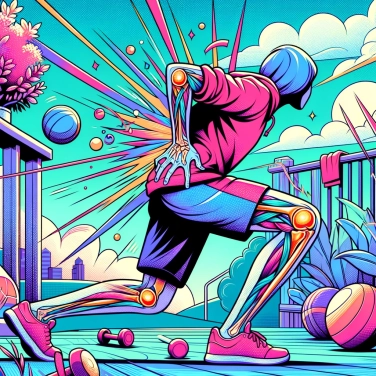Joint cracking is often caused by the formation and bursting of gas bubbles in the synovial fluid that lubricates the joints. When the bubbles burst, it creates a cracking sound.

In our joints, there is a fluid called synovial fluid that acts as a natural lubricant. When we stretch or bend a joint, the pressure in this fluid suddenly decreases. This rapid drop causes the formation of small gas bubbles, primarily composed of nitrogen and carbon dioxide. When these bubbles burst, we hear a distinctive little sound: this is what you call "cracking" a joint. This phenomenon is completely normal and harmless, as long as it doesn't cause any particular pain. After this sound, you need to wait a bit before you can crack the same joint again, allowing time for these bubbles to re-form gradually.
Our joints function a bit like sealed capsules filled with liquid, and when you move suddenly or stretch your fingers, you change the pressure inside. This sudden drop in pressure creates gas bubbles from the joint fluid. These small bubbles appear quickly and then implode suddenly, causing that characteristic cracking sound. It's exactly like when you quickly open a soda bottle: the sharp drop in pressure makes bubbles appear. Most of the time, this phenomenon is painless and has no long-term impact on joint health.
Frequently cracking your fingers, neck, or other joints can lead to a form of small habit. The body gets used to it, and one then feels a kind of lack or need to regularly reproduce this movement. When the joint is frequently engaged in the same position, the tendons or ligaments may slightly relax or temporarily shift. When they return to their original position, it creates an audible snap. Generally, this is not dangerous; however, repeating it too often or forcefully over the long term may weaken the joint tissues and cause chronic pain or discomfort.
Over time, articular cartilage naturally wears down: it's somewhat like a shoe sole that loses its cushioning with use. When this cartilage becomes thin or uneven, movements can create more friction, and inevitably, it can crack. Osteoarthritis, common with aging, also leads to less smooth joint surfaces, often resulting in minor unpleasant noises. Nothing dramatic most of the time, just the signs of a joint that has experienced a bit!
Synovial fluid is a thick, viscous fluid that serves to lubricate and protect the joints, much like oil in an engine. When its quality decreases (due to aging, an unbalanced diet, or lack of physical activity), lubrication becomes less effective. As a result, joint surfaces rub against each other more, increasing the chances of cracking. Poor-quality synovial fluid can also promote the formation of small gas bubbles, which burst and cause the characteristic cracking sound. Maintaining good hydration, a healthy diet, and staying active helps keep this fluid well-maintained, thus reducing joint cracking.
Dr. Donald Unger, an American researcher, voluntarily cracked the joints of one of his hands regularly every day for over 50 years, without noticing any significant differences compared to his other hand!
Today, it is established that joint cracking is primarily related to rapid changes in pressure within the joint. However, systematic cracking accompanied by pain warrants a medical opinion.
The phenomenon of joint cracking is known by a scientific term: 'cavitation.' This term refers to the formation and then the rapid implosion of gas bubbles present in the synovial fluid!
Did you know that a joint that has just cracked takes about 20 minutes to recreate the gas bubbles necessary for a new crack? That's why it's not possible to 'crack' your fingers on demand immediately after doing it once!
Not necessarily. The mere fact that a joint pops does not automatically mean the onset of osteoarthritis. However, when the popping is accompanied by frequent pain, inflammation, or a noticeable loss of mobility, it may indicate the beginning of joint wear, and it is recommended to consult a specialist.
Some people have a joint or ligament constitution that makes them more prone to joint cracking. This predisposition varies from person to person and is primarily related to the flexibility of the joints, the quality and quantity of synovial fluid, or repetitive joint habits.
It's just a widely spread myth. Currently, no serious study has been able to formally establish a direct link between regularly cracking one’s joints and the onset of arthritis or osteoarthritis in the long term.
In general, cracking your joints occasionally is not dangerous. However, if this phenomenon is accompanied by regular pain, stiffness, or swelling, it is advisable to consult a healthcare professional to ensure there is no underlying issue.
To limit joint cracking, it is beneficial to regularly practice stretching and maintain moderate physical activity to preserve joint flexibility. Additionally, staying adequately hydrated and adopting a balanced diet can help maintain the quality of synovial fluid.

No one has answered this quiz yet, be the first!' :-)
Question 1/5